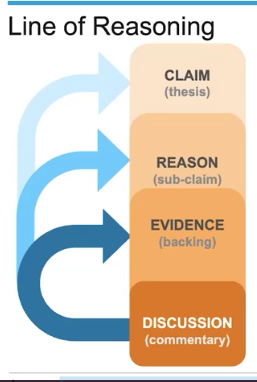AP Lang SEMESTER ONE FINAL
1/24
There's no tags or description
Looks like no tags are added yet.
Name | Mastery | Learn | Test | Matching | Spaced |
|---|
No study sessions yet.
25 Terms
Exigence
The specific occasion/event that prompted the message to be spoken/written.
Purpose
Why the speaker is conveying the message.
Audience
Who the writer is speaking to
Speaker
the character/persona of the writer(poet, comedian, scholar, expert, etc.)
Context
the circumstances surrounding the situation
Message
What the writer wants the audience to think or know
Line or Reasoning
the logical, organizational sequence of ideas a writer uses to support their thesis, connecting evidence and reasoning in a way that is persuasive
Counterargument
An opposing view or argument that challenges the writer’s claim
Concede
acknowledging the validity of an opposing argument to show fairness or build credibility
Refute
to disapprove or invalidate an opposing argument with evidence or reasoning
Rebuttal
A response that counts or weakens an objection or counterargument
Validity
The quality of being logically sound and well-founded
Provide the three appeals as well as their meaning or intention.
Ethos-appeals to shared beliefs/values
Pathos-appeals to emotion
Logos-Appeals to logic or Reason
There are eleven types of evidence. Provide all eleven types
Details
Facts
Statistics
Illustrations
Anecdotes
Analogies
Personal Observations
Personal Experiences
Expert Opinions
Testimonies
Experiments
There are eight provided examples of argumentative organization. List all eight examples.
Compare +Contrast
Cause + Effect
Problem/Solution
Logical by Claims/Reasons
Chronological Order
Order or Importance
Combination
Description
Provide the four modes or writing.
Argumentation
Exposition
Narration
Description
Typical Approach
Audience thinks like the speaker
Audience shares some similar values, beliefs, maybe even needs
Purpose is agreeable
Needs to be urged to action
Choose Your Details Well
How much specificity is needed?
Are there details that show the writer or speaker in a better light?
What obvious gaps must be filled in order to achieve your purpose?
Say it So It’s Received the Way You Intended
Consider the mode
Consider your audience
Consider how your audience may respond to your mode
Line of Reasoning

What are the three considerations for including evidence within the Line of Reasoning Hierarchy?
Consider the evidence that’s appropriate for the rhetorical situation
Consider a variety of evidence that establishes different rhetorical appeals
Consider how you want to present the evidence and in which order
The Classic
Introduction
Body 1: Argument 1
Body 2: Argument 2
Body 3: Counterargument
a. “detailing an objection” OR “ making a concession”
b. “meeting an objection” OR “making a refutation.”
Conclusion
The Diffuser
Introduction
Body 1: Counterargument
a. “detail Objection(s)” OR “making concession(s)”
Body 2: Argument 1(“meeting an objection” OR “refuting a concession”)
Body 3: Argument 2(“meeting an objection” OR “making a refutation”)
Conclusion
The Analyzer
Introduction
Body 1: Argument 1
a.) counterargument 1
i.)”detailing an objection” OR “ making a concession”
ii.)”meeting an objection” OR “making a refutation” (rebuttal)
Body 3: Argument 3
a.) counterargument 1
i.)”detailing an objection” OR “ making a concession”
ii.)”meeting an objection” OR “making a refutation” (rebuttal)
Body 3: Argument 3.
a.) counterargument 1
i.)”detailing an objection” OR “ making a concession”
ii.)”meeting an objection” OR “making a refutation” (rebuttal)
Conclusion
The Aggressor
Introduction
Body 1: Counterargument 1
a.) “detailing an objection” OR ”making a concession”
b.)”meeting an objection” OR “making a refutation”
Body 2: Counterargument 2
a.) “detailing an objection” OR ”making a concession”
b.)”meeting an objection” OR “making a refutation”
Body 3: Counterargument 3
a.) “detailing an objection” OR ”making a concession”
b.)”meeting an objection” OR “making a refutation”
Conclusion